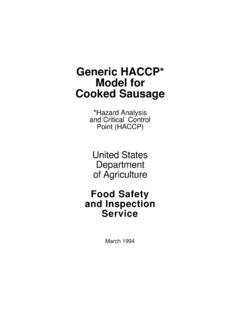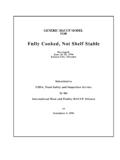Transcription of A RETAIL FOOD ESTABLISHMENT GUIDE FOR …
1 A RETAIL food ESTABLISHMENT GUIDE FOR. DEVELOPING A haccp PLAN. Meeting the Requirements of the FDA food Code in Relation to Specialized Meat and Poultry Processing Methods April 2014. Acknowledgements AFDO wishes to acknowledge the following groups and organization for their assistance in developing this guidance document: Minnesota Department of Agriculture USDA food Safety & Inspection Services AFDO food Committee Katherine Simon, Minnesota Department of Agriculture Jan Kelly, Minnesota Department of Agriculture Stan Stromberg, Oklahoma Department of Agriculture, food , & Forestry Joe Corby, AFDO. Krystal Reed, AFDO. Table of Contents Page Section 1: Introduction to food Safety 1. About haccp .. 1. haccp Requirements in the food Code .. 2. Definitions:.. 3. An Introduction to Preliminary Steps.
2 4. An Introduction to the 7 haccp 5. Section 2: The Preliminary Steps .. 8. Introduction .. 8. Step 1: Assemble the haccp Team .. 9. Step 2: Identify Products/Processes to be 11. Step 3: Develop a Complete List of Ingredients, Materials, .. 12. Equipment and Recipes/Formulations .. 12. Step 4 & 5: Develop and Verify a Process Flow Diagram .. 15. Conclusion:.. 17. Section 3: Utilizing the 7 Principles of haccp .. 18. Understanding Hazards and Controls .. 18. Principle 1: Hazard Analysis .. 24. Principle 2: Identify Critical Control Points .. 32. Principle 3: Establish Critical Limits for Each Critical Control Point .. 37. Principle 4: Establish Monitoring Procedures .. 40. Principle 5: Establish Corrective 43. Principle 6: Establish Record Keeping Procedures .. 46. Principle 7: Establish Verification Procedures.
3 48. Section 4: food Code Requirements .. 51. Introduction .. 51. Contents of a haccp Plan .. 52. Compliance with the haccp Plan .. 53. Variances and the haccp Plan .. 53. Reduced Oxygen Packaging .. 54. Section 5: Product and Processes .. 57. Jerky Products: Fully Cooked - Not Shelf Stable .. 59. Sausage Products: Fully Cooked - Not Shelf 66. Whole Muscle Meat/Poultry Products: Fully Cooked - Not Shelf Stable .. 74. Bacon Products: Not Fully Cooked - Not Shelf Stable .. 81. Reduced Oxygen Packaging (ROP) .. 86. Labeling .. 89. Sanitation Standard Operating Procedures (SSOP's) .. 90. Verification and Record Keeping .. 92. Section 6: Sample Forms .. 93. Appendix:.. 109. Common Foodborne Bacterial Pathogens .. 110. Sample food Safety 118. Section 1: Introduction to food Safety Systems About haccp .
4 What is haccp ? The Hazard Analysis Critical Control Point system is a preventative system for assuring the safe production of food products. It is based on a common sense application of technical and scientific principles to a food production process. The most basic concept underlying haccp is that of prevention. The food processor/handler should have sufficient information concerning the food and the related procedures they are using, so they will be able to identify where a food safety problem may occur and how it will occur. If the where' and how' are known, prevention becomes easy and obvious, and finished product inspection and testing becomes needless. The haccp program deals with control of factors affecting the ingredients, product and process. The objective is to make the product safely, and be able to prove that the product has been made safely.
5 The where and how are the HA (Hazard Analysis) part of haccp . The proof of the control of the processes and conditions is the CCP (Critical Control Point) part. Flowing from this basic concept, haccp is simply a methodical and systematic application of the appropriate science and technology to plan, control and document the safe production of foods. haccp is not the only method in ensuring that safe food products are manufactured. The plan will be successful when other procedures are in place such as sanitation standard operating procedures (SSOP's) and by using good manufacturing practices (GMP's). Although the food Code does not require them, these programs are fundamental in the development of a successful haccp plan. SSOP's should include personal hygiene practices as well as daily sanitation of the food contact surfaces and equipment.
6 Good sanitation practices are the foundation of manufacturing and preparing safe food . haccp is a management system in which food safety is addressed through the analysis and control of biological, chemical, and physical hazards from raw material production, procurement and handling, to manufacturing, distribution, and consumption of the finished product. For successful implementation of an haccp plan, management must be strongly committed to the haccp concept. A firm committed to haccp by top management, provides company employees with the sense of importance of producing safe food . 1. haccp Requirements in the food Code The food Code is a model for safeguarding public health and ensuring food is unadulterated and honestly presented when offered to the consumer. It represents FDA's best advice for a uniform system of provisions that address the safety and protection of food offered at RETAIL and in food service.
7 One of the provisions of the food Code is for RETAIL food establishments that conduct certain food processes or operations to operate under a haccp plan. RETAIL Meat and Poultry Processes or Operations that Require a haccp Plan: 1. Smoking or curing food , except for smoking done for the purpose of imparting flavor only, and not as a part of the part of the cooking process. 2. Using food additives or adding components, including vinegar, as a method to preserve food (rather than to enhance its flavor) or change food into a non-potentially hazardous food . 3. Using a reduced oxygen method of packaging food except where the growth and toxin formation by clostridium botulinum and the growth of listeria monocytogenes are controlled. 4. food Establishments that apply for a variance to: Deviate from required cooking times and temperatures for raw animal foods.
8 Custom processing animals that are for personal use as food and not for sale or service. Preparing food by a method determined by the regulatory authority to require a variance. Additional Requirements While the process of developing a haccp plan is a rather universal one, there are some additional components that need to be included as part of the firm's haccp plan. Section 4 provides details on the additional requirements such as standard operating procedures, duties of the person in charge. haccp plans that cover reduced oxygen packaging operations must include several additional pieces of information. 2. Definitions: CP Decision Tree: A sequence of questions to assist in haccp System: The result of the implementation of the determining whether a control point is a CCP. haccp Plan procedures to be followed.
9 Continuous Monitoring: Uninterrupted collection and haccp Team: The group of people who are responsible recording of data such as temperature on a strip chart, or for developing, implementing and maintaining the haccp . a continuous recording thermometer. system. Control: (a) To manage the conditions of an operation to Hazard: A biological, chemical, or physical agent that is maintain compliance with established criteria. (b) The reasonably likely to cause a food to be unsafe for state where correct procedures are being followed and consumption. criteria are being met. Hazard Analysis: The process of collecting and evaluating Control Measure: Any action or activity that can be used information on hazards associated with the food under to prevent, eliminate or reduce a significant hazard.
10 Consideration to decide which are significant and must be addressed in the haccp plan. Control Point: Any step at which biological, chemical, or physical factors can be controlled. Monitor: To conduct a planned sequence of observations Corrective Action: Procedures followed when a deviation or measurements to assess whether a CCP is under occurs. control and to produce an accurate record for future use in verification. Criterion: A requirement on which a judgment or decision can be based. Prerequisite Programs: Procedures, including Good Manufacturing Practices that address operational Critical Control Point (CCP): A point, step or procedure at conditions providing the foundation for the haccp . which control can be applied and is essential to prevent or system. eliminate a food safety hazard, or reduce it to an acceptable level.


